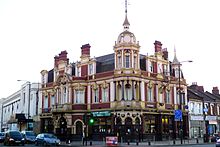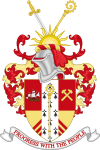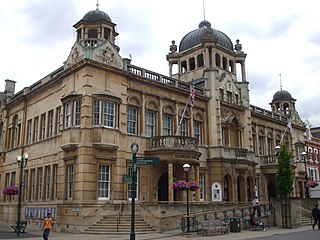
Ilford is a large town in East London, England, 9 miles (14 km) northeast of Charing Cross. Part of the London Borough of Redbridge, Ilford is within the ceremonial county of Greater London. It had a population of 168,168 in 2011, compared to 303,858 for the entire borough.

Romford is a large town in East London, England, 14 miles (23 km) northeast of Charing Cross. Part of the London Borough of Havering, the town is one of the major metropolitan centres of Greater London identified in the London Plan.
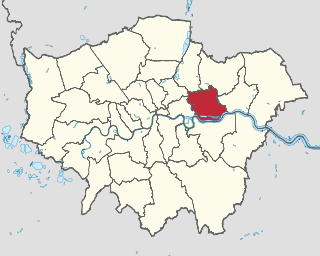
The London Borough of Newham is a London borough created in 1965 by the London Government Act 1963. It covers an area previously administered by the Essex county boroughs of West Ham and East Ham, authorities that were both abolished by the same act. The name Newham reflects its creation and combines the compass points of the old borough names. Situated in the Inner London part of East London, Newham has a population of 387,576, which is the fourth highest of the London boroughs and also makes it the 26th most populous district in England. The local authority is Newham London Borough Council.

East Ham is a district of the London Borough of Newham, England, 8 miles (12.8 km) east of Charing Cross. Within the boundaries of the historic county of Essex, East Ham is identified in the London Plan as a Major Centre. The population is 76,186.

Chadwell Heath is an area of Dagenham in East London, England. It is split between the London Borough of Barking and Dagenham and the London Borough of Redbridge, around 2 miles (3.2 km) west of Romford and 4 miles (6.4 km) east of Ilford, and 12 miles (19 km) north-east of Charing Cross.
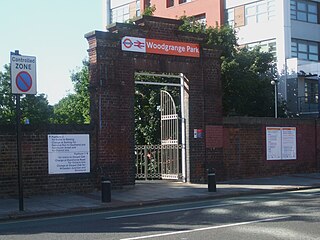
Woodgrange Park is a railway station on Romford Road in Manor Park in the London Borough of Newham, east London. It is served by London Overground and is on the Gospel Oak to Barking line. It is located 12 miles 1 chain (19.3 km) down the line from Gospel Oak; it lies in Travelcard Zones 3 and 4. It has only limited station buildings and facilities.
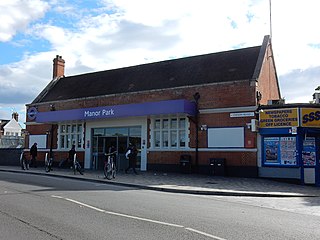
Manor Park railway station is on the Great Eastern Main Line serving Manor Park in the London Borough of Newham, east London. It is 6 miles 20 chains (10.1 km) down the line from London Liverpool Street and is situated between Forest Gate and Ilford. Its three-letter station code is MNP and it is in Travelcard Zone 3/4. It is currently managed and served by the Elizabeth line.

Beckton is a suburb in east London, England, located 8 miles (12.9 km) east of Charing Cross and part of the London Borough of Newham. Adjacent to the River Thames, the area consisted of unpopulated marshland known as the East Ham Levels in the parishes of Barking, East Ham, West Ham and Woolwich. The development of major industrial infrastructure in the 19th century to support the growing metropolis of London caused an increase in population with housing built in the area for workers of the Beckton Gas Works and Beckton Sewage Treatment Works. The area has a convoluted local government history and has formed part of Greater London since 1965. Between 1981 and 1995 it was within the London Docklands Development Corporation area, which caused the population to increase as new homes were built and the Docklands Light Railway was constructed.
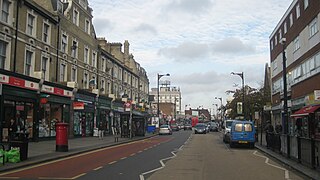
Forest Gate is a district in the London Borough of Newham, East London, England. It is located 7 miles (11 km) northeast of Charing Cross.

Upton Park is an area of the East London borough of Newham, centred on Green Street which is the boundary between West Ham and East Ham. West Ham United Football Club formerly played at the Boleyn Ground, commonly known as Upton Park.

Little Ilford is a district of London, England in the London Borough of Newham. It gives its name to the Little Ilford ward.

East London is the northeastern part of Greater London, England, east of the ancient City of London and north of the River Thames as it begins to widen. Containing areas in the historic counties of Middlesex and Essex, East London developed as London's docklands and the primary industrial centre. The expansion of railways in the 19th century encouraged the eastward expansion of the East End of London and a proliferation of new suburbs. The industrial lands of East London are today an area of regeneration, which are well advanced in places such as Canary Wharf and ongoing elsewhere.

Forest Gate railway station is on the Great Eastern Main Line serving Forest Gate in the London Borough of Newham, east London. It is 5 miles 21 chains (8.5 km) down the line from London Liverpool Street and is situated between Maryland and Manor Park. Its three-letter station code is FOG and it is in fare zone 3.

East Ham is a constituency in the London Borough of Newham represented in the House of Commons of the UK Parliament since its creation in 1997 by Stephen Timms of the Labour Party.

East Ham was a local government district in the far south west of Essex from 1878 to 1965. It extended from Wanstead Flats in the north to the River Thames in the south and from Green Street in the west to Barking Creek in the east. It was part of the London postal district and Metropolitan Police District.

Green Street is a road in the London Borough of Newham, East London, which forms much of the boundary between East and West Ham.

Becontree was an ancient hundred in the south west of the county of Essex, England. Its area has been entirely absorbed by the growth of London; with its name reused in 1921 for the large Becontree estate of the London County Council. Its former area now corresponds to the London Borough of Newham, the London Borough of Barking and Dagenham and parts of the London Borough of Waltham Forest and the London Borough of Redbridge. Its early extent also included parts of what is now the London Borough of Havering.

Elections to Newham London Borough Council in London, England was held on 6 May 2010. This was on the same day as other local elections and the general election to the UK Parliament.

St Mary's Church, or Parish Church of St Mary the Virgin, is a Church of England church in Little Ilford, east London. It is situated on Church Road (B165) between St Mary's Approach, St Winefride's Avenue and Rectory Road. It shares grounds with St Mary's Rectory, 124, Church Road, London, E12 6HA. Mainly 12th century, it had its chancel rebuilt and a south porch and family chapel to the Lethieullier family added in 1724. It remained a parish church until 1938, at which point it became a chapel of ease to St Michael's Church, Romford Road in Manor Park, London. It is listed at Grade I.


